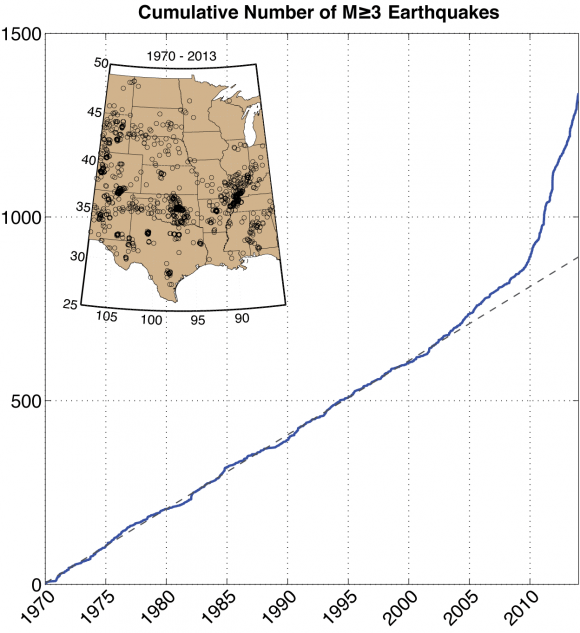
USGS image: The San Andreas Fault
aNewDomain commentary — The definition of induced seismicity reminds me of the plot of the 1985 James Bond movie A View to a Kill, where the bad guy, Max Zoran, plans to destroy Silicon Valley by creating a massive earthquake. His foolproof plan is to flood the San Andreas Fault with sea water, thereby inducing a seismic event. The perfect cause and effect criminal caper, at least until that meddling secret agent ruined everything.
I don’t know if the writers of that movie knew that the crux of Max Zoran’s plan had a scientific name, but the concept of induced seismicity is very real and very pertinent to citizens of the United States today.
Induced Seismicity
The concept of induced seismicity is not important because Silicon Valley is in danger of falling into the ocean anytime soon, but because of the relationship induced seismicity has with the production of oil and gas in the United States. Specifically, induced seismicity is very important with regard to the injection of wastewater in deep disposal wells. The wastewater in question is a common by-product of oil and gas production.
Simply put, induced seismicity refers to the seismic activity caused by human activity. This seismic activity includes tremors and small earthquakes, many of which go unnoticed by the human population. In the case of wastewater disposal, the activity results when the normal stresses found in the Earth’s crust are released by the presence of pressurized fluid.
According to research done by the United States Geological Survey, the number of earthquakes in central and eastern parts of the country increased “dramatically” between 2010 and 2012. A team of USGS scientists found that the increased activity coincided with the injection of wastewater in deep disposal wells. While induced seismicity in these instances has not been dangerous, scientists conducting the study notably chose not to rule out the potential for larger magnitude earthquakes.

USGS Image: Increasing seismic activity
This is certainly something to consider as more oil and gas production takes place in the lower 48 states. Highly populated areas could be impacted by induced seismic activity, which in turn could trigger larger magnitude events.
There is one other notable finding in the USGS study. The scientists found no links to increased seismic activity from the use of hydraulic fracturing. This is an interesting revelation because it would be natural to extrapolate the wastewater findings to include the controversial petroleum extraction technology known as “fracking.” It seems the USGS wants to make sure the general public doesn’t leap to any false conclusions.

USEIA image: Shale gas plays
Implications
The results of the USGS study are important because the United States is having an “energy renaissance” with the development of new sources of oil and gas located in miles-deep shale deposits. These deposits are located in states like Pennsylvania, Ohio and the Dakotas — areas of the country not often associated with tremors and earthquakes.
Finding and extracting this oil and gas creates jobs in these states and moves us toward energy independence from unstable foreign sources. However, those very good things must be weighed against the environmental consequences of the activity.
So, to make the best decisions about our energy future, it is vitally important we use actual scientific facts. The science now shows that induced seismicity has increased where deep wastewater disposal is deployed, but the impact of the induced seismic activity has been minimal. At the moment, I think I can live with that, but it does give one pause.
For aNewDomain.net, I’m Mark Kaelin.
Senior Editor Mark W. Kaelin has been writing and editing stories about the information technology industry, gadgets, finance, accounting, and tech-life for more than 25 years. Most recently, he was a senior editor for TechRepublic, a division of CBS Interactive, Inc. Follow him @MarkWKaelin and find him on Google + here.













We shouldnt be injecting ANY waste products back into the earth unless they came from the earth to begin with and this waste doesnt! It is NUTS to inject polluted after into the ground where IT WILL pollute drinking water supplies!
The waste-water in question is the saltwater recovered with the oil and natural gas being produced. Hello….this water DOES come from the earth. It is being injected thousands of feet below usable water strata.
Remember you don’t get cheaper gasoline without increased oil production. With more oil you get more saltwater and it has to be injected back into the earth.